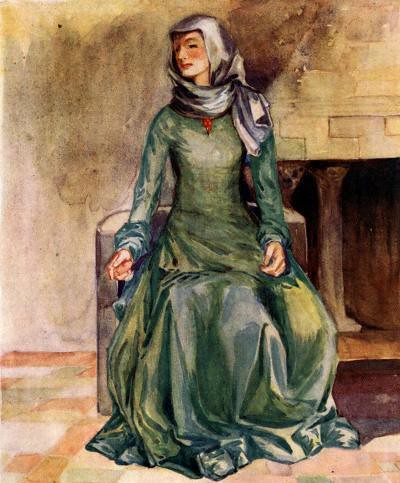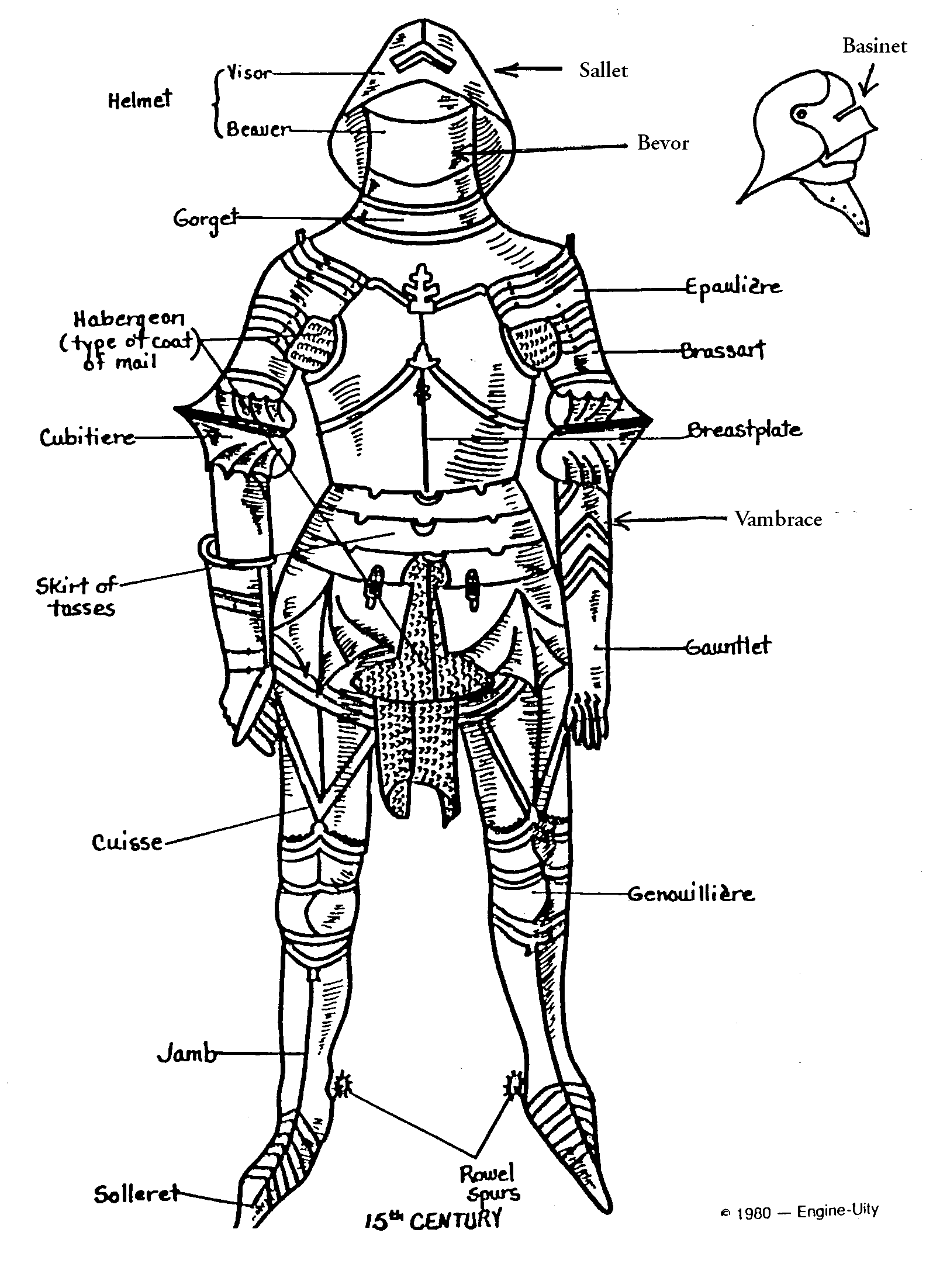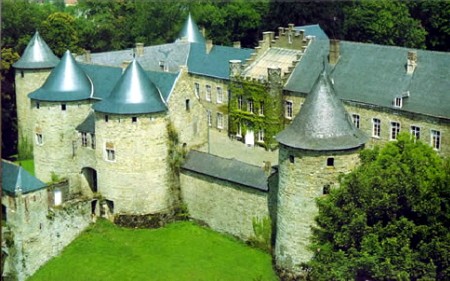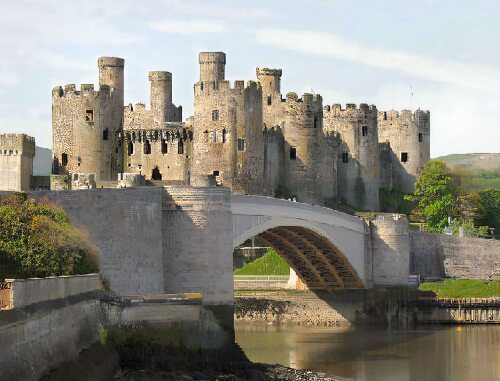|
Tuesday, December 7, 2010
Medieval Props
Medieval Clothing
There certainly were other people besides knights who wore regular clothes, not just heavy metal armor and shields. Just like during any other period of time in history medieval clothing came in a variety of styles which were based mainly on class issues. Whether you dressed in coarse abrasive materials that might rub your skin raw or in delicately sewn smooth silks depended solely on how much money you had. The wealthy dressed in finery while the peasants were lucky to have anything to wear at all. They were graceful for whatever clothing they had and the material mattered not to them. What class you belonged to was the deciding factor in how you dressed.

http://lexisproject.arts.manchester.ac.uk/gallery/clothing.html

http://lexisproject.arts.manchester.ac.uk/gallery/clothing.html
Medieval armor and Weapons

A knight was armed and armored to the teeth. He had so much armor and weapons that he depended on his squire to keep his armor and weapons clean and in good working condition. At first the armor was made of small metal rings called chain mail. A knight wore a linen shirt and a pair of pants as well as heavy woolen pads underneath the metal-ringed tunic. A suit of chain mail could have more than 200,000 rings. However, chain mail was heavy, uncomfortable, and difficult to move in. As time passed, knights covered their bodies with plates of metal. Plates covered their chests, back, arms, and legs. A bucket like helmet protected the knight’s head and had a hinged metal visor to cover his face. Suits of armor were hot, uncomfortable, and heavy to wear. A suit of armor weighed between forty and sixty pounds. Some knights even protected their horses in armor.
A knight also needed a shield to hold in front of himself during battle. Shields were made of either wood or metal. Knights decorated their shields with their family emblem or crest and the family motto.
A knight’s weapon was his sword, which was about thirty-two pounds. It was worn on his left side in a case fastened around his waist. A knife was worn on the knight’s right side. Knights used other weapons in combat as well. A lance was a long spear used in jousts. Metal axes, battle hammers, and maces were also used to defeat the enemy.
http://library.thinkquest.org/10949/fief/medknight.html
Knight Training
Combat/sword training is something that needs to be learned from a professional. Anything that required physical combat involves personal safety, injuries and such could happen if you try to learn combat/sword training on your own. As I've mentioned before, during the medieval times a knight needed to be wealthy to become such a status, but not only that you had to be physically fit as well. Tests were given to people who wanted to become knights. Wearing all those heavy armory was not a a walk in the park, so these tests were given for this exact reason. These videos will show some of the training and information on what it takes to become a skilled combat/sword fighter and the practices that comes with it.

Medieval Settings
There are too many castle designs during the Medieval time to distinguish what type is the best overall. But having too many options to choose from is not a horrible thing. It is always better to work with more options than not enough. Choosing one specific type of castle in making the set design is totally fine, you would definitely get the right idea of re-creating the play because of the fact that you use the correct scales. In a more simpler way it would be the "safe way" to go about doing things. But taking a chance and blending ideas together is an option that could be used as well. It would definitely give the audience something they have not seen before, drawing their attention more.




http://resimlerim.seesaa.net/article/140474537.html?googlesorgu=famous%20medieval%20castles%20pictures




http://resimlerim.seesaa.net/article/140474537.html?googlesorgu=famous%20medieval%20castles%20pictures
Medieval Knights
The knight was one of the three types of fighting men during the middle ages: Knights, Foot Soldiers, and Archers. The medieval knight was the equivalent of the modern tank. He was covered in multiple layers of armor, and could plow through foot soldiers standing in his way. No single foot soldier or archer could stand up to any one knight. Knights were also generally the wealthiest of the three types of soldiers. This was for a good reason. It was terribly expensive to be a knight. The war horse alone could cost the equivalent of a small airplane. Armor, shields, and weapons were also very expensive. Becoming a knight was part of the feudal agreement. In return for military service, the knight received a fief. In the late middle ages, many prospective knights began to pay "shield money" to their lord so that they wouldn't have to serve in the king's army. The money was then used to create a professional army that was paid and supported by the king. These knights often fought more for pillaging than for army wages. When they captured a city, they were allowed to ransack it, stealing goods and valuables.

Knowing what knights are suppose to look like is a very crucial aspect in re-making a medieval play, but going further and researching detailed information such as what the equivalent cost of a knight suit to the modern day can have a huge impact to actors. Understanding their character and the significance of their presence to the surroundings can make a difference in their acting.
http://library.thinkquest.org/10949/fief/medknight.html

Knowing what knights are suppose to look like is a very crucial aspect in re-making a medieval play, but going further and researching detailed information such as what the equivalent cost of a knight suit to the modern day can have a huge impact to actors. Understanding their character and the significance of their presence to the surroundings can make a difference in their acting.
http://library.thinkquest.org/10949/fief/medknight.html
Author J. Comyns Carr
Joseph William Comyns Carr (1 March 1849 – 12 December 1916) was an English drama and art critic, gallery director, author, poet, playwright and theatre manager.
Beginning his career as an art critic, Carr was a vigorous advocate for Pre-Raphaelite art and a vocal critic of the "short-sighted" art establishment. In 1877 he became a director of the Grosvenor Gallery and promoting Pre-Raphaelite painters and other important exhibitors, such as James McNeill Whistler, Dante Gabriel Rossetti and Edward Burne-Jones. Ten years later he founded the rival New Gallery.
Carr also wrote essays, books, plays, librettos, English-language adaptations of foreign works and stage adaptations of Dickens novels and classic tales like King Arthur and Faust.
Learning about the author can be helpful because you get to see how they've engaged in other work. Through reading their other plays they've written, you might be able to find something to relate to that you couldn't in the play in which you wanted to re-create.
http://en.wikipedia.org/wiki/J._Comyns_Carr
Beginning his career as an art critic, Carr was a vigorous advocate for Pre-Raphaelite art and a vocal critic of the "short-sighted" art establishment. In 1877 he became a director of the Grosvenor Gallery and promoting Pre-Raphaelite painters and other important exhibitors, such as James McNeill Whistler, Dante Gabriel Rossetti and Edward Burne-Jones. Ten years later he founded the rival New Gallery.
Carr also wrote essays, books, plays, librettos, English-language adaptations of foreign works and stage adaptations of Dickens novels and classic tales like King Arthur and Faust.
Learning about the author can be helpful because you get to see how they've engaged in other work. Through reading their other plays they've written, you might be able to find something to relate to that you couldn't in the play in which you wanted to re-create.
http://en.wikipedia.org/wiki/J._Comyns_Carr
The Script of King Arthur
Readings through the script is one of the most important aspect for dramaturg. The script will have all the information such as the title of the play, time period, all of the dialects, names, used props, etc. in which the dramaturg will need in order to fulfill the needs of the director and the cast.
http://books.google.com/books?id=y2GXGlu9kWAC&printsec=frontcover&dq=J.+Comyns+Carr&source=bl&ots=e9BrracOG3&sig=I_vGFm5oMeDnz-LZdXdQHVyuEWo&hl=en&ei=05z-TLbBEIyCsQOP_c2wCw&sa=X&oi=book_result&ct=result&resnum=6&ved=0CEQQ6AEwBQ#v=onepage&q&f=false
http://books.google.com/books?id=y2GXGlu9kWAC&printsec=frontcover&dq=J.+Comyns+Carr&source=bl&ots=e9BrracOG3&sig=I_vGFm5oMeDnz-LZdXdQHVyuEWo&hl=en&ei=05z-TLbBEIyCsQOP_c2wCw&sa=X&oi=book_result&ct=result&resnum=6&ved=0CEQQ6AEwBQ#v=onepage&q&f=false
King Arthur
The play "King Arthur" written by J. Comyns Carr can be represented as one of the plays during the Medieval times. King Arthur was the British leader in the late fifth and early sixth centuries. According to Medieval histories, he led the defense of Britain against Saxon invaders in the early sixth century. King Arthur is the figure at the heart of the Arthurian legends. He is said to be the son of Uther Pendragon and Ygraine of Cornwall.

http://www.lib.rochester.edu/camelot/arthmenu.htm
http://www.oxfordreference.com/views/ENTRY.html?entry=t204.e1761&srn=1&ssid=720594983#FIRSTHIT

http://www.lib.rochester.edu/camelot/arthmenu.htm
http://www.oxfordreference.com/views/ENTRY.html?entry=t204.e1761&srn=1&ssid=720594983#FIRSTHIT
Medieval Theatre
Medieval theatre refers to the theatre of Europe between the end of the Western Roman Empire and the beginning of the Renaissance. The term refers to a variety of genres because the time period covers approximately a thousand years. Most medieval theatre is not well documented due to a lack of surviving records and texts.
At the beginning of the Middle Ages, Roman Catholic Church banned theatrical performances, mostly as an attempt to curb the excesses of the Roman theatre. The Roman theatre was in decline because the economic and political conditions could not support the vast entertainment industry that had grown up in the empire and included circuses, horse races, gladiatorial combat, and the Roman comedies that are still sometimes performed today.
http://www.luminarium.org/medlit/medievaldrama.htm
http://library.cwu.edu/search~S0?/sTheatre+Journal/stheatre+journal/1,2,2,B/l856~b1873864&FF=stheatre+journal+online&1,1,,2,0
At the beginning of the Middle Ages, Roman Catholic Church banned theatrical performances, mostly as an attempt to curb the excesses of the Roman theatre. The Roman theatre was in decline because the economic and political conditions could not support the vast entertainment industry that had grown up in the empire and included circuses, horse races, gladiatorial combat, and the Roman comedies that are still sometimes performed today.
http://www.luminarium.org/medlit/medievaldrama.htm
http://library.cwu.edu/search~S0?/sTheatre+Journal/stheatre+journal/1,2,2,B/l856~b1873864&FF=stheatre+journal+online&1,1,,2,0
Subscribe to:
Posts (Atom)














